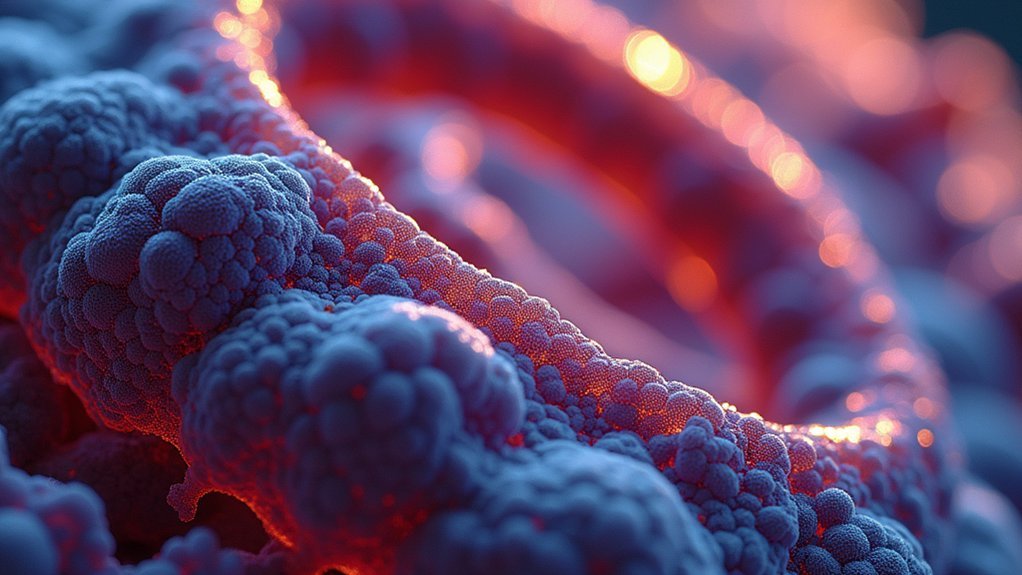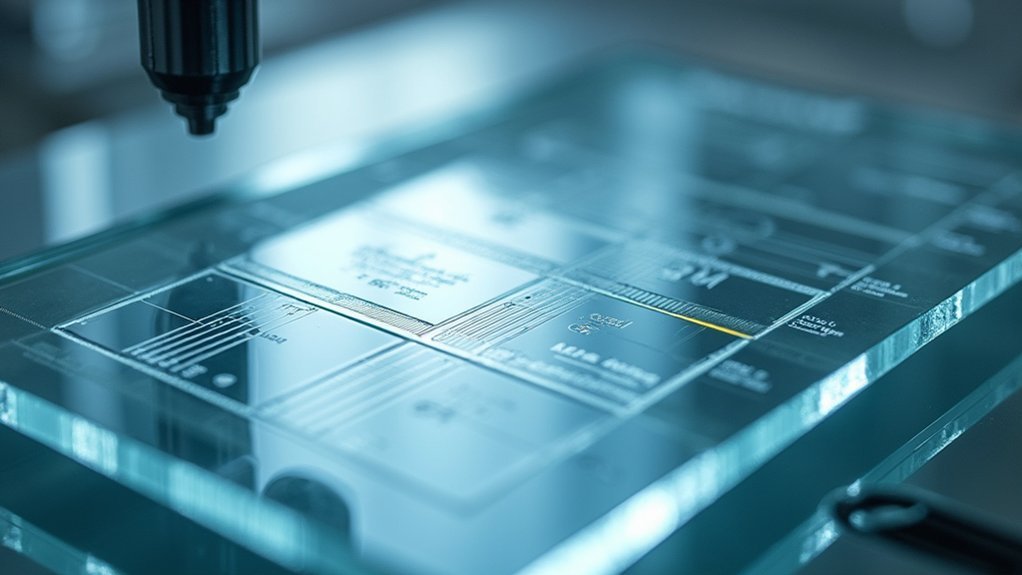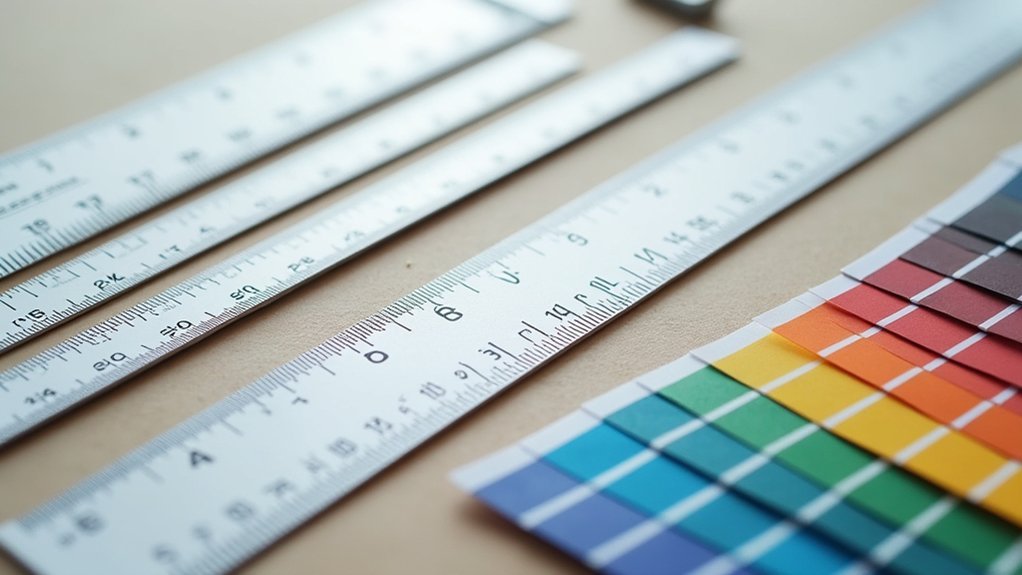You enhance contrast before capturing specimen images because it reveals critical details invisible to standard microscopy. With contrast as low as 2-5% in unstained specimens, pre-capture enhancement through phase contrast, DIC, or staining techniques makes structures immediately visible during examination. This preserves resolution better than digital post-processing and prevents data loss. The right technique transforms virtually invisible cells into clearly defined structures with authentic structural relationships intact.
The Fundamental Role of Contrast in Specimen Visibility

While many factors affect microscopic imaging quality, contrast stands as the cornerstone of specimen visibility. You’ll need a minimum contrast of 2 percent between your specimen and its background for the human eye to detect differences.
When you enhance contrast in optical microscopy, you’re greatly improving your ability to distinguish cellular components and tissue structures.
Remember that contrast represents the difference in light intensity between your specimen and its surrounding environment. Without sufficient signal-to-noise ratio, coherent image formation becomes impossible, regardless of magnification power.
High contrast doesn’t just make images more aesthetically pleasing—it enables accurate analysis by revealing subtle features that might otherwise remain hidden. Your staining techniques, light source adjustments, and proper optical setup directly impact your ability to achieve ideal contrast levels.
Common Challenges of Low-Contrast Specimens
Despite your best efforts at sample preparation, you’ll frequently encounter specimens that naturally resist visualization under the microscope. Unstained specimens, particularly live cells, typically display contrast values of only 2-5%, falling well below the threshold needed for effective brightfield microscopy examination.
You’re likely to face multiple obstacles simultaneously: artifacts from preparation can mask true cellular components, while optical aberrations create uneven light distribution across your field of view.
Variations in specimen thickness compound these issues, making consistent visualization nearly impossible. Background intensity fluctuations further complicate matters—darker backgrounds may enhance sensitivity to intensity changes, but won’t resolve fundamental contrast problems.
These challenges collectively impair the visualization process, rendering critical structures invisible and potentially compromising your entire analysis unless you implement appropriate contrast enhancement techniques.
How Light Interaction Affects Image Quality

The fundamental physics of light-specimen interaction directly determines what you’ll see in your microscope images. When transmitted light passes through transparent specimens, refractive index differences create phase shifts that your eyes can’t detect but greatly impact image quality.
Phase contrast microscopy capitalizes on these phase shifts, converting them into amplitude variations that enhance contrast in otherwise invisible structures. The optical transfer function measures how faithfully your imaging system reproduces specimen details, with contrast diminishing at higher spatial frequencies.
You’ll achieve better results by manipulating illumination techniques. Oblique or dark-field illumination can dramatically improve contrast by reducing stray light and accentuating edges.
Understanding these light interaction principles helps you overcome the limitations of conventional brightfield microscopy, especially when examining specimens with minimal natural contrast.
Essential Contrast Enhancement Techniques for Live Specimens
Essential dye applications can enhance specific cellular structures in your live specimens without causing immediate harm, allowing you to observe particular features that would otherwise remain invisible.
You’ll find specialized lighting methods such as phase contrast, DIC, and darkfield microscopy invaluable for transforming transparent specimens into clearly defined images with three-dimensional qualities.
When you combine selective staining with appropriate color filters, you’ll dramatically improve the visibility of cellular components while maintaining specimen viability.
Vital Dye Applications
Because living specimens present unique imaging challenges, essential dyes offer powerful solutions for enhancing contrast while maintaining cellular viability.
When you’re examining live cells, critical dyes like trypan blue and fluorescein selectively stain cellular structures without killing them, creating much-needed definition.
You’ll find these dyes absorb specific wavelengths of light, dramatically improving contrast between different cellular components under your microscope. They’re particularly valuable for evaluating cell viability, as they often differentiate between living and dead cells, providing immediate insights into cellular health.
Some critical dyes even fluoresce under specific light conditions, revealing intricate details during dynamic biological processes.
Remember to carefully control dye concentration and exposure time to preserve specimen integrity while achieving ideal contrast for your imaging needs.
Specialized Lighting Methods
While essential dyes offer valuable contrast in living specimens, advanced lighting methods represent a non-invasive alternative for visualizing cellular structures. You’ll find these techniques indispensable when studying unstained specimens in their natural state.
- Phase contrast microscopy transforms subtle phase variations into visible amplitude differences, revealing details in transparent cells 5-10 micrometers thick.
- Differential interference contrast (DIC) employs polarized light and Nomarski prisms to create striking three-dimensional images with enhanced resolution.
- Darkfield microscopy uses oblique illumination against a black background to dramatically highlight otherwise invisible microorganisms.
- Contrast enhancement through specialized lighting permits real-time analysis of cellular processes without disturbing natural behaviors.
These approaches prove vital in biological research by enabling detailed observation of dynamic cellular structures without compromising specimen viability through staining procedures.
Staining Methods That Optimize Detail Recognition

When examining microscopic specimens, proper staining techniques dramatically transform what you can see and interpret. Chemical dyes selectively absorb and reflect specific light wavelengths, enhancing visibility of internal structures that would otherwise remain invisible.
You’ll achieve ideal contrast by applying thin sections (1-30 microns) with appropriate stains.
Fluorescent dyes offer another powerful approach, emitting longer wavelengths when stimulated, highlighting particular cellular components with remarkable clarity. For complex specimens, you’ll benefit from dye mixtures that provide a broader color spectrum, allowing you to differentiate multiple structures simultaneously.
Don’t overlook the value of color filters during microscopy—they’ll further enhance detail recognition by selectively improving stained areas, such as darkening red regions while lightening green ones, creating the contrast necessary for accurate interpretation.
Digital Image Processing vs. Optical Contrast Methods
While digital image processing lets you enhance contrast after capture through techniques like histogram equalization, optical contrast methods provide real-time visual guidance as you examine specimens.
You’ll find that optical approaches preserve native resolution better since they manipulate light physically before it reaches the detector, whereas digital methods must work with already-captured pixel data.
Your choice between preprocessing (optical) and postprocessing (digital) should consider whether you need immediate feedback during observation or can enhance images later without compromising essential structural details.
Real-Time Visual Guidance
How can microscopists achieve ideal specimen visibility in real time? Real-time image processing provides immediate feedback on contrast levels, allowing you to adjust brightness and reduce noise while observing microscopic details.
When you combine digital image processing with optical contrast methods like phase contrast or differential interference contrast (DIC), you’ll greatly enhance specimen visibility without physical sample alteration.
- Use real-time adjustments to instantly recognize whether your chosen contrast technique reveals the structures you need to examine.
- Monitor how refractive index variations respond to different optical contrast methods for best clarity.
- Apply digital brightness adjustments to further enhance the contrast achieved through physical techniques.
- Toggle between processing algorithms to determine which best removes noise while preserving essential details in your specific specimen.
Preprocessing vs. Postprocessing
The difference between preprocessing and postprocessing greatly impacts your microscopy results and workflow efficiency.
When you apply preprocessing techniques like optical contrast methods—including phase contrast and differential interference contrast—you’re enhancing image quality before capture by converting phase shifts into amplitude changes. This makes low-contrast specimens immediately visible with improved specimen details.
While digital image processing offers post-capture options through brightness adjustment and noise reduction algorithms to improve overall image clarity, it’s often addressing problems that proper preprocessing could prevent.
You’ll find that effective preprocessing reduces your reliance on extensive postprocessing, preserving data integrity and preventing potential distortions.
Resolution Preservation Considerations
Resolution quality represents a key differentiator when comparing digital processing to optical contrast methods. When you capture images, optical techniques like phase contrast maintain inherent resolution while enhancing contrast in the image. Digital processing applied afterward often degrades fine details that can’t be recovered.
- High numerical aperture objectives maximize resolution potential through improved light collection and contrast generation.
- Phase contrast and other optical enhancements work with the modulation transfer function rather than against it.
- Digital image processing introduces artifacts that can permanently compromise resolution.
- Light microscopy benefits from contrast preservation at the optical level rather than through post-capture manipulation.
Remember that true resolution depends on making structures distinguishable at capture time—contrast adjustments after acquisition can’t reveal details that weren’t initially recorded with sufficient clarity.
Selecting the Right Contrast Technique for Your Specimen Type
When examining specimens under a microscope, choosing an appropriate contrast technique can mean the difference between seeing essential details and missing them entirely.
For unstained cells and transparent biological specimens, phase contrast enhances visibility by converting refractive index variations into light intensity differences. If you’re looking for three-dimensional detail with minimal artifacts, differential interference contrast (DIC) is your best option, particularly for thin specimens.
For stained samples, brightfield microscopy works well, but you can improve contrast by adding color filters.
Consider your specimen’s light scattering properties when selecting an illumination method—oblique or dark-ground illumination works exceptionally well for bacteria.
Remember that your mounting media’s refractive index considerably impacts image clarity, so match it appropriately to your contrast techniques and specimen type.
Balancing Contrast Enhancement and Artifact Prevention

Although contrast enhancement reveals critical specimen details, striking the right balance prevents misleading artifacts that can compromise your research findings. When you adjust optical settings, remember that excessive contrast can create halos that mask subtle boundaries and distort actual specimen properties.
- Optimize your optical system by fine-tuning refractive indices to match specimen characteristics rather than maximizing contrast indiscriminately.
- Consider techniques like phase contrast or DIC microscopy that enhance visibility without physically altering specimen integrity.
- Routinely calibrate your equipment to differentiate between true biological features and artifacts introduced by contrast manipulation.
- Start with minimal enhancement and gradually increase until you achieve clarity without introducing noise that detracts from image quality.
This balanced approach guarantees your contrast enhancement accurately represents the specimen while avoiding artifacts that could lead to misinterpretation.
Frequently Asked Questions
What Is the Importance of Contrast in Microscopy?
Contrast in microscopy enables you to differentiate cellular structures that would otherwise remain invisible. You’ll need at least 2% contrast to see details, which is why enhancement techniques are essential for accurate specimen analysis.
How Can You Improve Contrast When Viewing a Specimen?
You can improve contrast when viewing specimens by applying stains, using phase contrast or darkfield microscopy, adjusting the condenser aperture, or implementing differential interference contrast techniques. Each method highlights different specimen features effectively.
What Must Be Done to a Specimen to Increase the Contrast of the Structures Viewed?
To increase structural contrast, you’ll need to apply appropriate stains, prepare thin sections, adjust the condenser aperture, utilize specialized microscopy techniques like phase contrast, and consider using color filters for enhanced visualization.
What Methods Are Used to Increase Contrast of a Specimen in Bright Field Microscopy?
To increase contrast in brightfield microscopy, you’ll need to apply stains, reduce the condenser aperture, use color filters, adjust background intensity, and optimize diaphragm settings that highlight your specimen’s differential absorption and refractive properties.
In Summary
You’ll find that proper contrast enhancement transforms invisible details into clearly defined structures. Whether you’re using stains, optical methods, or digital processing, you’re fundamentally making the specimen tell its story more effectively. Remember, your goal isn’t just high contrast—it’s meaningful contrast that reveals true biological relationships. By selecting techniques appropriate for your specific specimen, you’ll capture images that both document and illuminate scientific truth.





Leave a Reply